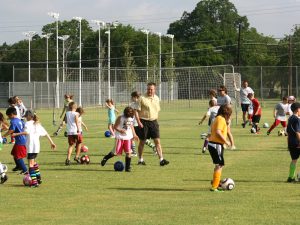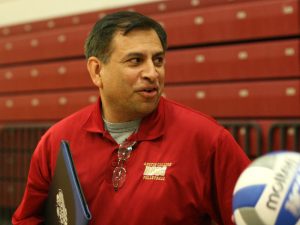College athletics has an ever-changing landscape, and Austin College is no exception. In the last 15 years, the College moved from the American Southwest Conference to the Southern Collegiate Athletic Conference, and as recently as the 1990s, held membership in the National Association of Intercollegiate Athletics before joining the NCAA Division III ranks.
Through the many changes during that span, two constants in Kangaroo athletics stand: women’s soccer coach Paul Burns and volleyball coach Ed Garza. Starting their careers at Austin College together in 1995, the two have become inextricably linked with Austin College and with success, boasting the two winning-est Kangaroo athletics programs of the past two decades.
Through it all, these coaches from very different backgrounds have forged a lasting friendship while continuing the successes that have marked their entire coaching careers.
 Burns, a native of England, was the first—and only—coach in the history of the Austin College women’s soccer program. He started the program from scratch, a process that is supposed to be long and arduous. Since the first season’s expected ups and downs, Burns has done something quite unexpected: put together a string of 14 consecutive winning seasons, an unheard of achievement for a program only 15 years old.
Burns, a native of England, was the first—and only—coach in the history of the Austin College women’s soccer program. He started the program from scratch, a process that is supposed to be long and arduous. Since the first season’s expected ups and downs, Burns has done something quite unexpected: put together a string of 14 consecutive winning seasons, an unheard of achievement for a program only 15 years old.
 Garza, who grew up in south Texas, took over an already established program when he became the Kangaroo volleyball team’s fifth coach since the program began in 1977. Prior to Garza’s arrival, the team had won a total of 160 matches in nearly 20 years. In the 15 years of Garza’s guidance, the team has won an incredible 353 matches, or an average of 23.5 wins per season.
Garza, who grew up in south Texas, took over an already established program when he became the Kangaroo volleyball team’s fifth coach since the program began in 1977. Prior to Garza’s arrival, the team had won a total of 160 matches in nearly 20 years. In the 15 years of Garza’s guidance, the team has won an incredible 353 matches, or an average of 23.5 wins per season.
Both Garza and Burns have brought conference championships to Austin College along with multiple NCAA National Tournament berths.
With their combined achievements over such a long stretch, one might think it’s been an easy ride for their programs—but that couldn’t be further from the truth. The coaches have seen drastic changes in college athletics and have had to keep pace to maintain their winning ways.
“Things are so much more competitive now,” says Burns, referring both to the College’s move to the prestigious SCAC as well as the recruiting process. “When I began the program, there was only one NCAA Division I women’s soccer program in Texas. Now, there are 15, as well as more Division III programs. It’s such a smaller recruiting pool than it used to be.”
One of the keys to maintaining his success in terms of recruiting, Burns said, is beginning the process even earlier. “You’ve got to focus and spend time on underclassmen,” he said, “because the upperclassmen already have committed to schools.”
Garza has a bit of an edge in recruiting through his work with club volleyball. Many of his Austin College players have played for Garza on the club circuit throughout their careers. Garza also credits Austin College’s admission staff for helping to ease the process.
“We’ve got great resources,” said Garza. “We have a great volleyball facility, and we’ve got the support of our outstanding faculty, who always are willing to work with our student-athletes. The recruiting process takes up a lot of time, but Austin College works with these kids to help make their dreams come true.”
Challenges obviously remain, and like Burns, Garza points to the ultra-competitive nature of the SCAC, a conference which regularly boasts multiple teams ranked in the American Volleyball Coaches Association Top 25 poll. And, most years, Austin College is one of those, thanks to the excellence Garza has infused into the program.
One thing Burns has had to learn to maintain his own success is the need to understand and adapt to the social and cultural changes in student-athletes.
“Today you see a very different type of student-athlete,” said Burns. “They are very involved in so many activities now, and that makes some things better and some things more challenging. They can multitask and communicate more easily, though because of their other involvements, sometimes it is a little more difficult to get them to focus on one task.”
Of course, ask any of Burns’ former players and they’d probably say not only the student-athletes have changed—but Burns himself. He likely would likely be the first to agree, recalling times when former players have attended recent games and gotten the impression that the coach has gotten soft over the years.
“I’m still driven to compete,” said Burns. “But I’ve become better at dealing with losses than I was 15 years ago.”
Those losses are few and far between, which Burns credits to the idea that if student-athletes buy in to what is taught to them, wins will be come more often than losses. “You have to give them self-belief and put them in the right position to be as successful as possible, and help them develop as people,” Burns said.
The two coaches have learned from each other over the years “When we first started here, we both had many of the same challenges,” said Garza. “Those shared experiences have made it easier to help one another overcome issues more quickly. It’s always been helpful to get a different point of view on how to overcome obstacles.”
Let the overcoming continue as the coaches take on their 16th Austin College fall athletics seasons.




